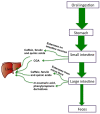Role of Chlorogenic Acids in Controlling Oxidative and Inflammatory Stress Conditions
- PMID: 26712785
- PMCID: PMC4728630
- DOI: 10.3390/nu8010016
Role of Chlorogenic Acids in Controlling Oxidative and Inflammatory Stress Conditions
Abstract
Chlorogenic acids (CGAs) are esters formed between caffeic and quinic acids, and represent an abundant group of plant polyphenols present in the human diet. CGAs have different subgroups that include caffeoylquinic, p-coumaroylquinic, and feruloyquinic acids. Results of epidemiological studies suggest that the consumption of beverages such as coffee, tea, wine, different herbal infusions, and also some fruit juices is linked to reduced risks of developing different chronic diseases. These beverages contain CGAs present in different concentrations and isomeric mixtures. The underlying mechanism(s) for specific health benefits attributed to CGAs involves mitigating oxidative stress, and hence the related adverse effects associated with an unbalanced intracellular redox state. There is also evidence to show that CGAs exhibit anti-inflammatory activities by modulating a number of important metabolic pathways. This review will focus on three specific aspects of the relevance of CGAs in coffee beverages; namely: (1) the relative composition of different CGA isomers present in coffee beverages; (2) analysis of in vitro and in vivo evidence that CGAs and individual isomers can mitigate oxidative and inflammatory stresses; and (3) description of the molecular mechanisms that have a key role in the cell signaling activity that underlines important functions.
Keywords: anti-inflammation; antioxidant activity; chlorogenic acid isomers; coffee; inflammatory stress; oxidative stress.
Figures
Similar articles
-
Structure- and dose-absorption relationships of coffee polyphenols.Biofactors. 2014 Jan-Feb;40(1):103-12. doi: 10.1002/biof.1101. Epub 2013 Mar 29. Biofactors. 2014. PMID: 23553742
-
Catabolism of coffee chlorogenic acids by human colonic microbiota.Biofactors. 2013 Nov-Dec;39(6):623-32. doi: 10.1002/biof.1124. Epub 2013 Aug 1. Biofactors. 2013. PMID: 23904092
-
Roasted and green coffee extracts show antioxidant and cytotoxic activity in myoblast and endothelial cell lines in a cell specific manner.Food Chem Toxicol. 2018 Apr;114:119-127. doi: 10.1016/j.fct.2018.02.029. Epub 2018 Feb 13. Food Chem Toxicol. 2018. PMID: 29452189
-
Coffee Chlorogenic Acids Incorporation for Bioactivity Enhancement of Foods: A Review.Molecules. 2022 May 25;27(11):3400. doi: 10.3390/molecules27113400. Molecules. 2022. PMID: 35684338 Free PMC article. Review.
-
Antihypertensive effects and mechanisms of chlorogenic acids.Hypertens Res. 2012 Apr;35(4):370-4. doi: 10.1038/hr.2011.195. Epub 2011 Nov 10. Hypertens Res. 2012. PMID: 22072103 Review.
Cited by
-
Comparison of Neurogenesis Promotion Effects between Cinnamoylquinic Acids in Neural Stem Cells from Adult Mice Brains.ACS Chem Neurosci. 2024 Sep 30;15(20):3713-23. doi: 10.1021/acschemneuro.4c00329. Online ahead of print. ACS Chem Neurosci. 2024. PMID: 39348888 Free PMC article.
-
Chlorogenic Acid Potentiates the Anti-Inflammatory Activity of Curcumin in LPS-Stimulated THP-1 Cells.Nutrients. 2020 Sep 4;12(9):2706. doi: 10.3390/nu12092706. Nutrients. 2020. PMID: 32899726 Free PMC article.
-
The caffeic acid moiety plays an essential role in attenuating lipid accumulation by chlorogenic acid and its analogues.RSC Adv. 2019 Apr 17;9(22):12247-12254. doi: 10.1039/c8ra09395d. eCollection 2019 Apr 17. RSC Adv. 2019. PMID: 35515874 Free PMC article.
-
Molecular Mechanisms That Define Redox Balance Function in Pathogen-Host Interactions-Is There a Role for Dietary Bioactive Polyphenols?Int J Mol Sci. 2019 Dec 10;20(24):6222. doi: 10.3390/ijms20246222. Int J Mol Sci. 2019. PMID: 31835548 Free PMC article. Review.
-
Neuroprotective Effects of Chlorogenic Acid in a Mouse Model of Intracerebral Hemorrhage Associated with Reduced Extracellular Matrix Metalloproteinase Inducer.Biomolecules. 2022 Jul 22;12(8):1020. doi: 10.3390/biom12081020. Biomolecules. 2022. PMID: 35892330 Free PMC article.
References
-
- Farah A., Donangelo C.M. Phenolic compounds in coffee. Braz. J. Plant Physiol. 2006;18 doi: 10.1590/S1677-04202006000100003. - DOI
Publication types
MeSH terms
Substances
LinkOut - more resources
Full Text Sources
Other Literature Sources
Research Materials



